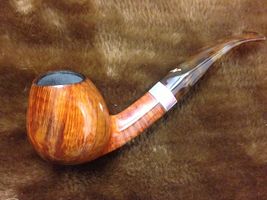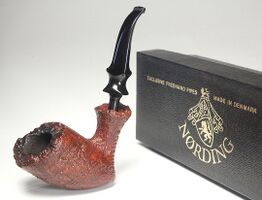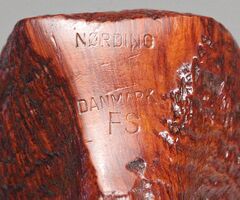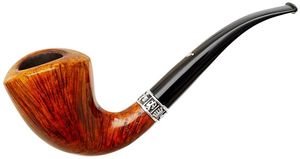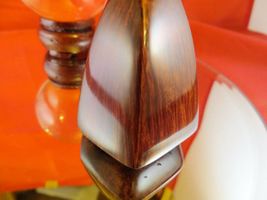Nørding
Erik Nørding was born in Copenhagen, Denmark. Originally educated in engineering. Pipe carving began as a hobby, but as time went by, he became more interested in pipe making as a profession. During the last 40 years Erik Nørding has built his own business, which today produces approximately 50.000 pipes a year, 90% of which are for the export market. From pipe design innovations to knife making to custom machinery and barbecue cookery, Erik Nørding´s inventiveness keeps expanding.
A blacksmith and engineer, Nørding knows his way around pipe making machinery. Strangely, it was not his love for woodworking that propelled Erik Nørding into the pipe making field — it was his terrific facility with machines.
Interview[1]
"I started as a blacksmith at age 15," he says, sitting comfortably in the game room of his home outside of Copenhagen, Denmark. He looks like a blacksmith. As he smokes his pipe, his hard, powerful hands seem to overpower the simple tasks of lighting and tamping. "My father was a blacksmith and an engineer," he says. "He had a razor blade and garden tool factory and passed away when I was 16 years old. I started working as a boy in the factory on a stamping machine, just to earn some money."
He pauses to remember, looking up toward the ceiling. The walls are lined with hunting trophies. Thirty or 40 game animals stare glassily from their mounts into the center of the room: Black bear, grizzly bear, antelope, elk, moose, deer, impala, wildebeest, gnu, wild boar, caribou — even a huge tiger shark. Nørding is the Ernest Hemingway of pipe makers, an inveterate sportsman.
It was about the time of his father's death that Nørding learned the blacksmith trade. His mother knew that to ensure his future he needed more expertise than that. "She wanted me to prepare to run the factory." says Nørding. "She said, 'You must learn engineering to run this company, because you must know more than the people who work here.' So I went to school and became an engineer."
- Nørding 18 High Grade with Sterling Mount, Courtesy Dennis Dreyer
But by the time he finished his education, Nørding had lost interest in the family factory. "That's because I had started making pipes," he says, holding up the Nørding hunting pipe he is smoking. "And pipes are much more interesting than razor blades."
He had been smoking pipes since he was 15 years old. "I bought my first pipe long before ever thought of making one," he says. That is too young an age to smoke, of course, and his mother had thought she could dissuade him from this new activity by providing a large enough dose to make him never smoke again. She said to me, 'You want to smoke? OK, here, smoke this pack of cigarettes.' She thought I would get sick. But I smoked one, then another, and as I reached for another one she said, 'Never mind. That's enough.' And it was decided that I could smoke one bowl of tobacco each day, but only at home."
Nørding's father. a pipe smoker himself, taught the young novice how to properly pack, light and enjoy a pipe. "I was very proud," says Nørding. "My father taught me to relax with the pipe. Not to inhale." It was much better than the cigarettes, and Nørding's love for pipes has since then continued and grown.
- Examples and nomenclature, courtesy Doug Valitchka
Long before he graduated from engineering school at age 25 he was a more experienced pipe smoker than most men his age. He frequented a pipe shop in Copenhagen and often had his pipes repaired there. "The guy who did the repairs in that shop" says Nørding. "could see that it was a good business, and he wanted to start his own pipe making shop." That repairman's name was Skovbo. One day he approached the young Erik Nørding with a proposition. "You are a blacksmith and an engineer," Skovbo said to Nørding. "You must know a lot about machinery. Can you make me some pipe making machinery?"
"I told him I could make anything he wanted," says Nørding. "But I didn't have any money. So I borrowed S200 to buy some bearings, and I scoured junkyards for old broken machinery. I bought inexpensive housings and put in new bearings and new shafts." It was Nørding's first contract and he wanted to get a good start, so he took great care in making the best possible tools for the pipe maker. "I made him a little polishing machine, and a lathe, and a sander for shaping pipes." When he had everything put together and running perfectly, he called Skovbo and told him his machinery was finished.
"He came out and looked it over," says Nørding. "He turned on the electricity and watched everything run. He had some blocks of wood with him, and he tried everything out. Finally he looked at me and said, 'It's exactly as I wanted. Perfect. How much do I owe you?' I told him the price — I don't remember how much it was, but it was very inexpensive."
Skovbo thought the price was very good. "That's fantastic," he said. "The price is right. Now I'll start out for myself, make some pipes and when I earn some money I'll pay you."
- Two Nørding 20's, Erik's Highest Grade with Sterling Mount, Courtesy Dennis Dreyer
- Photos by David Goostree
It must have been a terrifically discouraging moment for a young man who had just completed what he thought was his first paying job in a new career. As Erik Nørding now remembers that moment, sitting in a beautiful home that contains a pipe making shop large enough for 20 workers making tens of thousands of world-famous pipes, his face exhibits amusement at that memory. But back then, as a youngster trying to get a foothold in the world, his expression must have been more akin to horror.
"I told him that was not good enough," says Nørding. "I told him I was a poor man, I didn't have any money, I needed to be paid for my work." But Skovbo told Nørding that he couldn't pay him.
"Then I will keep the machinery," said Nørding. "I'll make pipes myself."
"You don't know how to use this machinery," said Skovbo. "You know nothing of pipe making."
"Well, you're not getting it. You should have told me before I did all this work that you didn't have the money to pay for it."
Skovbo thought it over. "Why don't we start together?" he said.
That's how Erik Nørding became a pipe maker.
There are still a few of those early pipes around. "I saw some at a shop I visited a while back," says Nørding. "The shop owner offered to give them to me as mementos but I refused. They may be worth quite a bit of money to collectors. You never know"
But they didn't sell for much when the business was first starting. Nørding still remembers the first traditionally shaped pipe he ever made. "It was a little pipe, a classic billiard. It looked terrible. It was made well, and I'm sure it smoked very nicely, but it didn't look so good." It was Christmas time, and a lady wandered into the pipe factory looking for a gift for her nephew. "I told her that we had sold out because of the season" "But that she could have that little billiard I had just finished for $5.10." The lady thought it looked fine, but it was more money than she wanted to spend. "She worked at the chocolate factory across the street," he says. "The workers had been given a lot of chocolate for Christmas, and she offered to trade chocolate for that pipe." Nørding seemed destined never to be paid for his work. "But it was very good chocolate."
Those first pipes carried the name "SON", which was an acronym for the combination of the names Skovbo and Nørding. Each of the partners borrowed $5,500 to get the business going, to rent a space and get the electricity turned on and to buy two bags of briar. Skovbo taught Nørding how to make pipes, "but I didn't have much time because I was still studying," says Nørding. "And I never got the chance to learn much from him, because shortly after we started he said that I would never be a pipe maker, he said that my hands had no skill for the craft, that I could never learn. I never understood how he could make such a judgment, but he did."
To his credit, Nørding shows no sign of triumph in the fact that he has proved Skovbo wrong by becoming one of the best-known pipe makers in the world. "He said that he would continue with SON pipes alone, that he no longer needed me," says Nørding. However, the partners had a legal agreement that whoever wished to dissolve the partnership first would leave the company to the remaining partner and be paid off without interest over five years. So Nørding became the one to keep the company.
- Early 1960's SON (Skovbo og Nørding) D Grade with Horn Shank Extension, Courtesy Dennis Dreyer
- SON examples and nomenclature, courtesy Doug Valitchka
It was difficult. Nørding was finishing school, paying off his partner and trying to make pipes. "I could make a pipe that was smokable," he says, "but not beautiful." The ability to craft the sculptures that Nørding pipes have become was a long process. However, he struck upon an idea. "I was a blacksmith; I could make anything out of metal if I had a drawing to work from. Why not do the same with pipes?"
He began visiting pipe shops, asking if any of them had customers who wanted pipes carved to specific designs, and he found that the need was there. "My first customer was a shop in Copenhagen. It needed some very big pipes for a customner — he just couldn't find them big enough." Nørding obtained drawings and made six pipes for the client. "They looked terrible," he says, laughing. "I couldn't get the scratches out, I couldn't get them polished right, and I couldn't get the colors even, but the measurements were exactly as he specified. He loved those pipes, and was a good customer of mine for many years.
Nørding kept working and kept improving. Finally he received his engineering degree, but was too embroiled in pipe making to pursue this career, though his knowledge in this area has certainly been complementary to his pipe business over the years. And of course by that time he was having too much fun making pipes to consider going back to the family razor blade factory — though his interest in keen edges has maintained itself and he still does a great deal of knife making.
Nørding continued with SON pipes for only a year or two before changing the company name to Nørding in the mid-'60s. "I figured nobody could ever take that name away from me," he says. Nørding's were exclusively freehand shapes, graded from A, B, C, D, up to its highest grade, extra. Later an "F" grade was added — less expensive than the "A."
Consumer interest in Danish freehand pipes helped Nørding expand throughout the 1970s and early '80´s. "They were easier for me to carve," he says, "because nobody in those days knew the free-hands. We were making thousands and thousands of those." The Nørding factory at that time reached its peak production, and Nørding employed 52 workers.
- Early Nørding A Grade, Courtesy Dennis Dreyer
Things have slowed somewhat since, and currently Nørding employs 6 pipe makers, who produce approximately 15,000 pipes a year. They work in the shop that takes up the lower level of the Nørding residence. It's spacious, more than 800 square meters, with three main workrooms, several smaller offices, and a large storage area for the 20,000 blocks of briar kept on hand, which comes mainly come from Corsica and Greece. "I don't age it," says Nørding. "I allow it to dry properly, so it ages a little during that process, but once it is dry it's fine for pipe making. All this talk about it being necessary for briar to age 30 years or whatever for good pipes, in my opinion, is nonsense. I've seen every stage of harvesting. I've been out digging the briar; I've been to sawmills; I've experienced everything. And I'm telling you, once you can dry a piece of briar without it cracking, it is ready to work."
The stems for Nørding pipes are all hand cut, though they are made in an assembly line style, thousands at a time, to save production costs. Free-hands are the least expensive of the Nørding line, all given their basic shape on a fraising machine that Nørding modified using government airplane parts. After they are roughed out, freehands are given individual shapes on sanding disks, then finished in a variety of colors and fitted with vulcanite stems.
Handmades are given more care and more individuality and feature acrylic mouthpieces, though the main difference is the quality of the grain. About 300 Handmades are produced each month. "The Handmades have become very popular, and demand has been increasing," says Nørding, "especially over the last three years."
Collectors have also been enthusiastic about the Nørding Hunting Series, which is a specially designed pipe, different every year, with a hunting theme. "I've not yet decided on the year 2002," says Nørding. But the immense popularity of the series indicates that there will certainly be one.
Even with all this, Erik Nørding keeps inventing new things. Hundreds of unusual pipe designs, various patents, and knife designs fill his offices. And he is currently expanding a new business in Demnark: Barbecue style catering. "Barbecue is almost unheard of in Denmark," he says. "But it's going to be big."
Perhaps the most famous of his more unusual achievements, though, is his giant Nørding pipe fashioned from hundreds of other pipes and mouthpieces. This pipe has been on display in several public venues, including the Copenhagen airport, and has been named the world's largest pipe by the Guinness Book of Records.
That's just one more example of Erik Nørding's tireless creativity. In all his pursuits, he strives to excel. "I enjoy everything I do," he says. "I live hard, play hard, and I work hard."
Seconds by Erik Nørding:
- Aalbørg
- Eriksen
- Eriksen (Nørding second) Examples and nomenclature, courtesy Doug Valitchka
Contact Information
Erik Nørding Pipes Banegraven 9 DK - 3550 Slangerup Denmark Phone: (+45) 4733 3733, Fax:(+45) 4738 0628 Email: erik@nordingpipes.com Homepage: Erik Nørding Pipes
References
- ↑ Informations based on an interview and compiled by Chuck Stanion.


